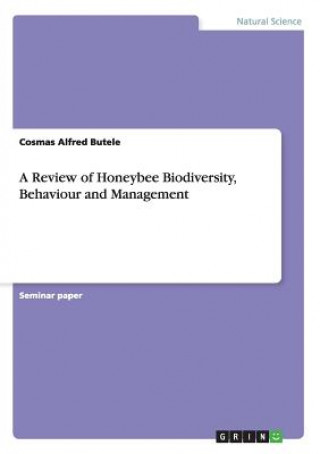
Livrare
Consilier de cumpărături





Nu se pretează? Nu contează! La noi puteți returna bunurile în 30 de zile
 Voucher cadou
orice valoare
Voucher cadou
orice valoare
Cu un voucher cadou nu veți da greș. În schimbul voucherului, destinatarul își poate alege orice din oferta noastră.
Review of Honeybee Biodiversity, Behaviour and Management
 engleză
engleză
 112 b
112 b
30 de zile pentru retur bunuri
Ar putea de asemenea, să te intereseze


Seminar paper from the year 2012 in the subject Biology - Zoology, grade: A, Atlantic International University (School of Science and Engineering), course: Master of Science (Applied Entomology), language: English, comment: Dear Butele: Excelent essay. "It's a big mistake also because, as I suggested earlier, educated people at the beginning of XXI century should be rationally founded confidence in the results of science, and rationally founded that confidence can only come from an adequate idea of scientific rationality, otherwise the trust is based only on the authority of science, and trust only authority is something that violates the rational and autonomous quality of the people". Olivé (2008, p. 77). Best regards, Dr ... Advisor. Atlantic International University. , abstract: Bees evolved in specific areas of the world long ago, before they spread to becomeglobally as they are today (Tables 1 and II), according to Kugonza (2009). As theyspread, they became adapted to the local ecological conditions of the different areas,changing in morphology and behaviour to fit within the requirements of the ecosystem,giving rise to a wide bee biodiversity of bee species and races we see today. Bees areclassified under Animal Kingdom, Phylum Arthropoda. They belong to Class Insecta,which is divided into 29 Orders. Bees belong to the order Hymenoptera, which has threeSuper families, namely: Apoidea (bees), Formicoidea (ants) and Vespoidea (wasps).There are around 30,000 named species of bees (Apoidea). Apoidea is further dividedinto several Families, namely Apidae (social bees), colletidae, Andrenidae, Halictidae,Melittidae, Megachilidae, and Anthophoridae. Most of the Families have solitaryindividuals: each female bee makes her own nest, lays a single egg and provides food forthe single larva that develops. However, a high level of social development is shown bythe species in Apidae where the individuals live together in a permanent, large colony,headed by a single egg-laying queen (BfD, 2003c). Apidae is composed of four genera:Apis (honeybees), Trigona and Melipona (stingless bees), and Bombus (bumble bees).According to MAAIF (2012a), the genus Apis is comprised of 5 main species of honeybees: Apis dorsata (the giant honey bee); Apis laboriosa (the darker giant honey bee);Apis florea (the little or dwarf honey bee); Apis cerana (formerly Apis indica), is theeastern hive honey bee; and Apis mellifera (western honey bee). These species haveevolved and differentiated into more species and races of honey bees. Kugonza (2009)described 9 species of honey bees in the world, which Oldroyd and Wongsiri (2006)grouped under 3 subgenera: Micrapis (Apis florea and A. andreniformis), Megapis (A.dorsata and A. laboriosa) and Apis (A. cerana, recently recognized as separate races ofA. nigrocinta, A. koschevnikovi and A. nuluensis, and A. mellifera). Dietz (1992), Hussein(2000) and Wikipedia (2012) described over 28 races of A. mellifera alone. Beekeepingstarted with honey bees (Apis species), a practice called Apiculture, although keeping ofstingless bees, belonging to the genera Trigona and Melipona, a practice calledMeliponiculture, has recently picked up [...]
Informații despre carte
 engleză
engleză




 Cum să cumpăr
Cum să cumpăr





























